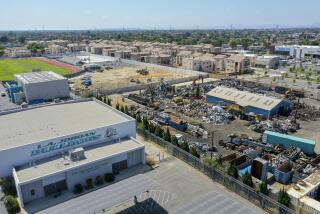Fatal Rocketdyne Blast Linked to Improper Waste Disposal, Study Says : Inquiry: Test that killed two scientists last year appears to have been a ‘disguise for destroying’ unwanted materials, report finds.
- Share via
State investigators probing the blast that killed two Rocketdyne physicists last year believe the men were improperly disposing of explosive waste, rather than conducting technical experiments, as Rocketdyne officials have claimed.
A report by state occupational health and safety officials said the test explosion that killed Otto K. Heiney and Larry A. Pugh appeared to be “a disguise for destroying” volatile waste material, which may have included chemicals used in making decoy flares for heat-seeking missiles.
The suspicion that Rocketdyne has been secretly blowing up waste apparently lies at the heart of a federal criminal investigation that surfaced last week when FBI and other agents raided the company and confiscated records related to waste disposal. Sources close to the case say the probe focuses on whether Rocketdyne defrauded the U.S. government of millions of dollars over the past several years by improperly disposing of hazardous waste in breach of federal cleanup contracts and environmental laws.
Cal/OSHA has already fined Rocketdyne more than $200,000 for numerous health and safety code violations in the fatal July 26, 1994, explosion. The company has appealed the citations.
If it were proven, however, that the test blasts at Rocketdyne’s Santa Susana Field Laboratory near Simi Valley were a cover for improper waste disposal, the company could be exposed to much greater liability.
In addition to the state and federal probes, lawyers for the two victims’ families are expected to file lawsuits against Rocketdyne, and perhaps other parties, within the week to beat a one-year statute of limitations on the incident.
Rocketdyne representatives Wednesday declined to comment on the investigations.
The Cal/OSHA probe, which concluded last January, found that standard safety procedures, such as spacing test blasts far apart and wearing flame-retardant clothing, were not followed.
Furthermore, the report by inspector George K. MacDonald said Rocketdyne records showed no training for the two physicists in conducting such explosions, confirming other accounts that at least one of the men had no such experience.
Heiney, said sources close to him, was a ballistics expert who thought up field tests for others to carry out but rarely performed them himself.
“Primarily his expertise was in gun testing. . . . Actually handling chemicals and explosives is not something that I’ve known him to do. That was completely out of character,” said Ronald Simmons, a close friend and former colleague of Heiney’s when the two worked at Eglin Air Force Base near Pensacola, Fla.
Simmons, now a chemist for the U.S. Navy in Maryland, said Heiney had half-jokingly referred to a waste-disposal dilemma at Rocketdyne about a week before the fatal accident.
Heiney had described the company’s position as “a Catch-22 situation, where . . . the damned rules and regulations [say that] they can’t store this stuff any longer, they can’t get a permit to open-burn it, and they can’t ship this stuff anywhere, so what the hell do [they] do?” Simmons said.
In their investigation, Cal/OSHA investigators said that Heiney, 53, and Pugh, 51, appeared to be burning off hazardous chemicals illegally at the time they died.
Directly after the explosion, Rocketdyne stated the test blasts were part of an experiment to determine the characteristics of certain propellants for packaging and transport. President Paul Smith said at the time that the scientists were recording shock waves from controlled explosions.
But Cal/OSHA inspectors noted that they saw none of the measuring devices necessary for such tests to yield valid data. Moreover, photographs showed evidence of compounds used in making missile decoys.
One source familiar with the incident characterized the blasts as “bucket tests”--Rocketdyne slang for tests of no real scientific value designed merely to get rid of hazardous waste, including excess rocket fuel.
Under federal environmental laws, criminal penalties for knowingly burning off hazardous waste carry fines of $50,000 per day per violation and up to five years in prison. In extraordinary cases, the fines can reach $1 million per day per violation.
Federal charges, if any, are likely to be weeks or months away. About 40 operatives, from agencies ranging from the Environmental Protection Agency to NASA, took part in last week’s raid of Rocketdyne’s Santa Susana lab and Canoga Park headquarters.
More to Read
Sign up for Essential California
The most important California stories and recommendations in your inbox every morning.
You may occasionally receive promotional content from the Los Angeles Times.














